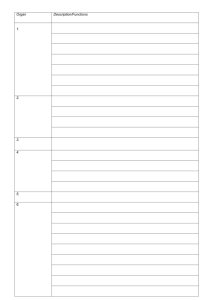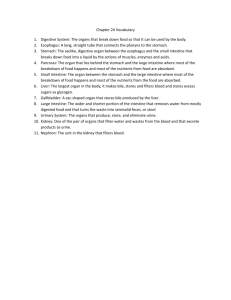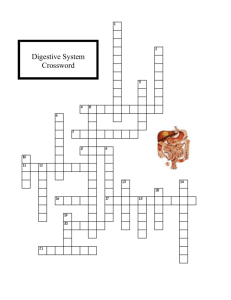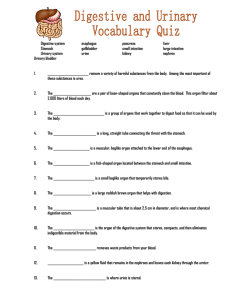File
advertisement
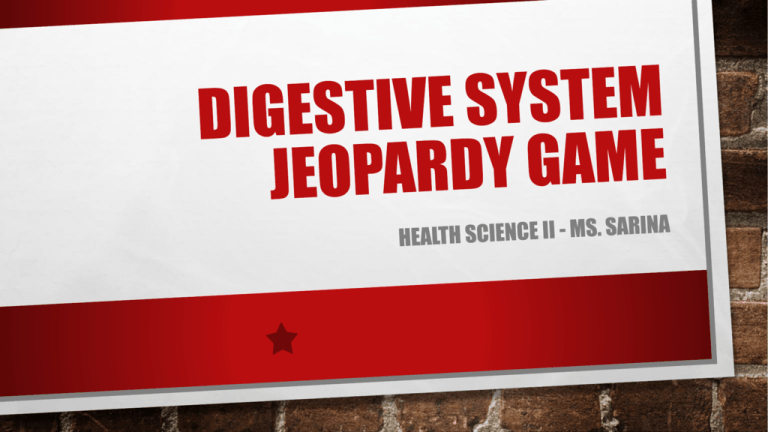
INSTRUCTIONS • GROUP THE CLASS INTO 5 GROUPS • HAVE EACH GROUP PICK A DOLLAR VALUE ($100, $200, $300, $400, HIGHER VALUE REPRESENTS MORE DIFFICULT QUESTIONS) • AFTER THE TEACHER READ THE QUESTION, EACH GROUP HAVE MAXIMUM OF 15 SECONDS TO ANSWER THE QUESTION BY WRITING THE ANSWER ON THE BOARD (TO AVOID ANY MISCOMMUNICATION) • GROUPS WITH HIGHEST SCORE RECEIVE FULL MARK FOR TODAY’S CLASS ACTIVITY (10 POINTS) THE DIGESTIVE SYSTEM Structure and Function of the Digestive Tract (Alimentary Cannel) Structure and Function of the Accessary Organs Processes in the Digestive System $100 $100 $100 $200 $200 $200 $300 $300 $300 $300 $300 $300 $300 $400 $400 $100 $100 $100 $100 $200 $200 $100 $100 $200 $200 $200 $200 $400 $300 $300 $100 $100 $300 QUESTION Match the following phase with appropriate process A) mechanical breakdown B) propulsion C) defecation D) ingestion E) absorption F) digestion 1. placement of food into the mouth 2. peristalsis moves food from one organ to the next 3. transport of food products from the lumen of the GI tract to the blood or lymph 4. physically fragmenting food particles into smaller particles 5. elimination of indigestible food residues from the GI tract as feces 6. enzymatic reactions that hydrolyze food particles into their building blocks End Answer Return $300 QUESTION Match the following phase with appropriate process 1) mechanical breakdown D. 2) Propulsion B. 3) Defecation E. 4) Ingestion A. 5) Absorption C. 6) Digestion F. A. placement of food into the mouth B. peristalsis moves food from one organ to the next C. transport of food products from the lumen of the GI tract to the blood or lymph D. physically fragmenting food particles into smaller particles E. elimination of indigestible food residues from the GI tract as feces F. enzymatic reactions that hydrolyze food particles into their building blocks Return $400 QUESTION A) organ where carbohydrate absorption occurs B) organ where starch digestion begins Match the digestive organ with their primary functions: C) tube through which food is propelled to the stomach but lacks a digestive role 1) Stomach D) organ where protein digestion begins 2) Esophagus E) organ where pancreatic enzymes and bile enter the alimentary canal 3) Small intestine 4) large intestine F) organ where bacteria synthesize vitamin K 5) Mouth G) organ where defecation reflex is initiated Answer End Return $400 QUESTION A) organ where carbohydrate absorption occurs B) organ where starch digestion begins Match the digestive organ with their primary functions: C) tube through which food is propelled to the stomach but lacks a digestive role 1) Stomach D D) organ where protein digestion begins 2) Esophagus C 3) Small intestine A and/or E E) organ where pancreatic enzymes and bile enter the alimentary canal 4) large intestine G 5) Mouth B F) organ where bacteria synthesize vitamin K G) organ where defecation reflex is initiated Return $400 QUESTION Match the following nutrients with their associated digestive enzymes: A) pepsin 1) Protein B) nuclease 2) Lactose C) lipase 3) Starch D) lactase 4) Fat E) amylase 5) Nucleic acids Answer End Return $400 QUESTION Match the following nutrients with their associated digestive enzymes: A) pepsin 1) Protein A B) nuclease 2) Lactose D C) lipase 3) Starch E D) lactase 4) Fat C E) amylase 5) Nucleic acids B Return $400 QUESTION Identify the structures A to O Answer End Return $400 QUESTION Identify the structures A to O A. Mouth B. Tongue C. Esophagus D. Liver E. Gall bladder F. Small intestine G. Anus O. Salivary Glad N. Pharynx M. Stomach L. Pancreas K. Pancreas J. Large intestine I. Rectum H. Appendix Return $100 QUESTION The process of physically and chemically breaking food particles down is referred to as ________. A) digestion B) defecation C) ingestion D) absorption Answer End Return $100 QUESTION The process of physically and chemically breaking food particles down is referred to as ________. A) digestion B) defecation C) ingestion D) absorption Return $100 QUESTION The ________ runs from the pharynx through the diaphragm to the stomach. A) trachea B) esophagus C) larynx D) small intestine Answer End Return $100 QUESTION The ________ runs from the pharynx through the diaphragm to the stomach. A) trachea B) esophagus C) larynx D) small intestine Return $300 QUESTION The ________ sphincter, or valve, controls food movement from the stomach into the small intestine. A) ileocecal B) cardioesophageal C) pyloric D) anal Answer End Return $300 QUESTION The ________ sphincter, or valve, controls food movement from the stomach into the small intestine. A) ileocecal B) cardioesophageal C) pyloric D) anal Return $200 QUESTION Large wrinkle-like folds in the stomach lining, present when the stomach is empty, that allow for expansion when the stomach is filling are called ________. A) villi B) haustra C) microvilli D) rugae Answer End Return $200 QUESTION Large wrinkle-like folds in the stomach lining, present when the stomach is empty, that allow for expansion when the stomach is filling are called ________. A) villi B) haustra C) microvilli D) rugae Return $200 QUESTION The three subdivisions of the small intestine are ________. A) cecum, colon, rectum B) duodenum, jejunum, ileum C) cardiac, body, pylorus D) ileum, cecum, rectum Answer End Return $200 QUESTION The three subdivisions of the small intestine are ________. A) cecum, colon, rectum B) duodenum, jejunum, ileum C) cardiac, body, pylorus D) ileum, cecum, rectum Return $200 QUESTION The fingerlike projections of the small intestine increase the surface area and are known as ________. A) haustra B) cilia C) villi D) rugae Answer End Return $200 QUESTION The fingerlike projections of the small intestine increase the surface area and are known as ________. A) haustra B) cilia C) villi D) rugae Return $100 QUESTION Bile is formed by the ________. A) spleen B) liver C) gallbladder D) pancreas Answer End Return $100 QUESTION Bile is formed by the ________. A) spleen B) liver C) gallbladder D) pancreas Return $100 QUESTION The process of chewing is known as ________. A) deglutition B) segmentation C) peristalsis D) mastication Answer End Return $100 QUESTION The process of chewing is known as ________. A) deglutition B) segmentation C) peristalsis D) mastication Return $200 QUESTION The enzyme produced by the salivary glands used in the breakdown of starches is salivary ________. A) chymotrypsin B) nuclease C) amylase D) lipase Answer End Return $200 QUESTION The enzyme produced by the salivary glands used in the breakdown of starches is salivary ________. A) chymotrypsin B) nuclease C) amylase D) lipase Return $100 QUESTION The active, voluntary process of placing food in one's mouth is ________. A) defecation B) ingestion C) mastication D) deglutition Answer End Return $100 QUESTION The active, voluntary process of placing food in one's mouth is ________. A) defecation B) ingestion C) mastication D) deglutition Return $100 QUESTION When digestion is not occurring in the small intestine, bile is stored in the ________. A) liver B) gallbladder C) pancreas D) spleen Answer End Return $100 QUESTION When digestion is not occurring in the small intestine, bile is stored in the ________. A) liver B) gallbladder C) pancreas D) spleen Return $100 QUESTION The process of eliminating indigestible residues from the GI tract is called ________. A) deglutition B) segmentation C) mastication D) defecation Answer End Return $100 QUESTION The process of eliminating indigestible residues from the GI tract is called ________. A) deglutition B) segmentation C) mastication D) defecation Return $300 QUESTION Hydrochloric acid is necessary in the stomach for the conversion of pepsinogen into its active protein-digesting form called ________. A) pepsin B) rennin C) amylase D) peptidase Answer End Return $300 QUESTION Hydrochloric acid is necessary in the stomach for the conversion of pepsinogen into its active protein-digesting form called ________. A) pepsin B) rennin C) amylase D) peptidase Return $100 QUESTION Sugars and starches are types of organic compounds known as ________. A) nucleic acids B) lipids C) proteins D) carbohydrates Answer End Return $100 QUESTION Sugars and starches are types of organic compounds known as ________. A) nucleic acids B) lipids C) proteins D) carbohydrates Return $300 QUESTION 2) Which one of the following represents the correct order through which food passes in the alimentary canal? A) mouth, pharynx, esophagus, stomach, large intestine, small intestine B) mouth, esophagus, pharynx, stomach, small intestine, large intestine C) pharynx, mouth, esophagus, stomach, large intestine, small intestine D) mouth, pharynx, esophagus, stomach, small intestine, large intestine E) mouth, pharynx, esophagus, small intestine, stomach, large intestine End Answer Return $300 QUESTION 2) Which one of the following represents the correct order through which food passes in the alimentary canal? A) mouth, pharynx, esophagus, stomach, large intestine, small intestine B) mouth, esophagus, pharynx, stomach, small intestine, large intestine C) pharynx, mouth, esophagus, stomach, large intestine, small intestine D) mouth, pharynx, esophagus, stomach, small intestine, large intestine E) mouth, pharynx, esophagus, small intestine, stomach, large intestine Return $300 QUESTION What sphincter regulates the passage of food from the esophagus into the stomach? A) internal anal sphincter B) external anal sphincter C) ileocecal sphincter D) pyloric sphincter E) cardioesophageal sphincter Answer End Return $300 QUESTION What sphincter regulates the passage of food from the esophagus into the stomach? A) internal anal sphincter B) external anal sphincter C) ileocecal sphincter D) pyloric sphincter E) cardioesophageal sphincter Return $300 QUESTION The small intestine extends from the ________. A) cardioesophageal sphincter to the pyloric sphincter (valve) B) pyloric sphincter (valve) to the ileocecal valve C) ileocecal valve to the appendix D) appendix to the sigmoid colon E) cardioesophageal sphincter to ileocecal valve Answer End Return $300 QUESTION The small intestine extends from the ________. A) cardioesophageal sphincter to the pyloric sphincter (valve) B) pyloric sphincter (valve) to the ileocecal valve C) ileocecal valve to the appendix D) appendix to the sigmoid colon E) cardioesophageal sphincter to ileocecal valve Return $300 QUESTION What organs release secretions into the duodenum of the small intestine? A) pancreas and spleen B) appendix and liver C) liver and pancreas D) cecum and appendix E) spleen and liver Answer End Return $300 QUESTION What organs release secretions into the duodenum of the small intestine? A) pancreas and spleen B) appendix and Peyer's patches C) liver and pancreas D) cecum and appendix E) spleen and liver Return $200 QUESTION Enzymes and bile are carried by the pancreatic duct and bile duct into the ________. A) duodenum B) jejunum C) ileocecal valve D) ileum E) large intestine Answer End Return $200 QUESTION Enzymes and bile are carried by the pancreatic duct and bile duct into the ________. A) duodenum B) jejunum C) ileocecal valve D) ileum E) large intestine Return $100 QUESTION One of the main functions of the small intestine is ________. A) absorption of nutrients B) absorption of water C) waste secretion D) vitamin conversion E) mineral secretion Answer End Return $100 QUESTION One of the main functions of the small intestine is ________. A) absorption of nutrients B) absorption of water C) waste secretion D) vitamin conversion E) mineral secretion Return $200 QUESTION Which one of the following is NOT a subdivision of the large intestine? A) cecum B) appendix C) duodenum D) colon E) rectum Answer End Return $200 QUESTION Which one of the following is NOT a subdivision of the large intestine? A) cecum B) appendix C) duodenum D) colon E) rectum Return $100 QUESTION The organ responsible for drying out indigestible food residue through water absorption and the elimination of feces is the ________. A) stomach B) large intestine C) small intestine D) pancreas E) liver Answer End Return $100 QUESTION The organ responsible for drying out indigestible food residue through water absorption and the elimination of feces is the ________. A) stomach B) large intestine C) small intestine D) pancreas E) liver Return $200 QUESTION What is the purpose of mastication? A) to eliminate undigested food wastes from the body B) to propel food from one digestive organ to the next C) to transport nutrients into the blood and lymph D) to chew, grind and tear food into smaller pieces while in the mouth E) to move food back and forth along the walls of the small intestine End Answer Return $200 QUESTION What is the purpose of mastication? A) to eliminate undigested food wastes from the body B) to propel food from one digestive organ to the next C) to transport nutrients into the blood and lymph D) to chew, grind and tear food into smaller pieces while in the mouth E) to move food back and forth along the walls of the small intestine Return $200 QUESTION The propulsive process that moves food from one organ to the next is called ________. A) ingestion B) peristalsis C) digestion D) mastication E) absorption Answer End Return $200 QUESTION The propulsive process that moves food from one organ to the next is called ________. A) ingestion B) peristalsis C) digestion D) mastication E) absorption Return $100 QUESTION Proteins are digested to their building blocks which are called ________. A) peptides B) amino acids C) polypeptides D) fatty acids E) glycerol Answer End Return $100 QUESTION Proteins are digested to their building blocks which are called ________. A) peptides B) amino acids C) polypeptides D) fatty acids E) glycerol Return $200 QUESTION Which one of the following alimentary segments has NO digestive function? A) cardial region of the stomach B) pyloric region of the stomach C) mouth D) esophagus E) duodenum Answer End Return $200 QUESTION Which one of the following alimentary segments has NO digestive function? A) cardial region of the stomach B) pyloric region of the stomach C) mouth D) esophagus E) duodenum Return $300 QUESTION Digestion of proteins begins in the ________________. A) large intestine B) mouth C) small intestine. D) stomach E) liver Answer End Return $300 QUESTION Digestion of proteins begins in the ________________. A) large intestine B) mouth C) small intestine D) stomach E) liver Return $300 QUESTION Which layer of the alimentary canal surrounds the lumen? A) chyme B) mucus C) epithelium D) smooth muscle E) bolus Answer End Return $300 QUESTION Which layer of the alimentary canal surrounds the lumen? A) chyme B) mucus C) epithelium D) smooth muscle E) bolus Return $300 QUESTION Organ where carbohydrate absorption occurs A) stomach B) esophagus C) small intestine D) large intestine E) mouth Answer End Return $300 QUESTION Organ where carbohydrate absorption occurs A) stomach B) esophagus C) small intestine D) large intestine E) mouth Return $300 QUESTION What is the terminal (last) portion of the small intestine? A) pyloric sphincter B) ileum C) cardioesophageal sphincter D) cecum E) ileocecal valve Answer End Return $300 QUESTION What is the terminal (last) portion of the small intestine? A) pyloric sphincter B) ileum C) cardioesophageal sphincter D) cecum E) ileocecal valve Return
